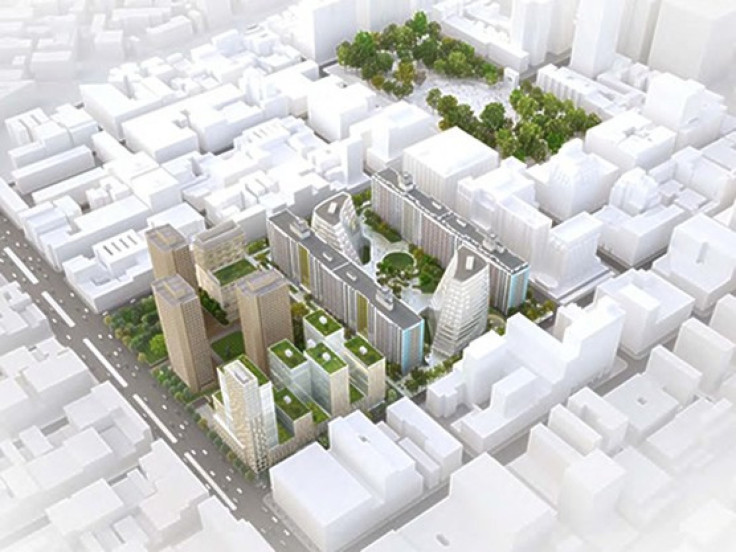Building New York: NYU 2031 Returns Controversy to Silver Towers

In the past week, New York University officially began the long approval process for its plan to add four new buildings to two superblocks just south of Washington Square Park in Greenwich Village.
Over the next seven months, the school will receive feedback from the local Community Board 2, Borough President Scott Stringer and eventually require approvals from the City Planning Commission and the City Council.
The opposition has been fierce. Local residents and preservation groups have long battled NYU's various development projects, which have involved demolition of existing buildings, including the former Palladium nightclub and St. Ann's Church. These new buildings, they argue, will overwhelm the neighborhood, first with noisy construction, and then by their sheer mass. They point out that the proposed 3 million square feet in new construction would be more mass than the Empire State Building. They call for the school to seek space in Lower Manhattan or elsewhere -- anywhere but the Village.
NYU has said that the plans will require no tenant displacement or eminent domain--in contrast to its northern neighbor Columbia's growth or the controversial genesis of Atlantic Yards, both of which led to various lawsuits. NYU has also implemented 40,000 square feet in public open space, offering renderings of idyllic playgrounds and carpets of green. And it has the backing of construction industry and elements of the city government that cite the economic benefits of universities.
The final result will likely be some sort of compromise. But it isn't the first time that the area, known as Washington Square Village and Silver Towers, has been at the center of turbulent changes to the urban fabric.
Robert Moses, the dominant parks commissioner who reshaped the city with a heavy hand, demolished nine city blocks there in the name of urban renewal in the 1950s, displacing 191 buildings, although only 16 were residential, according to the Landmarks Preservation Commission's 2008 report. Around that time, his proposed Lower Manhattan Expressway, which would have driven an elevated highway through the heart of downtown, was defeated by a coalition of local residents led by Jane Jacobs.
The northern superblock was eventully sold to NYU, which would build a row of academic buildings, while the two southern ones were sold to private developers Paul Tishman, a scion of the large construction company, and Morton Wolf. But the two developers had problems capitalizing on their new properties, and in 1960, NYU would buy the southern lots for $10.50 per square foot, an amount that critics called a steal.
The school would hire James Ingo Freed of I.M. Pei & Associates (now Pei Cobb Freed & Partners) as the main architect for a trio of new 30-story towers, which were completed in 1967. The buildings have become modernist icons for brutalist architecture, which favors raw concrete surfaces, as well as symbolizing towers in the park -- the practice of surrounding dense residential housing, particularly those that are publicly subsidized, with vegetation. (The concept extends somewhat to commercial buildings, such as One Liberty Plaza, which was granted a zoning bonus from Zuccotti Park, One Chase Manhattan Plaza, and the original World Trade Center, which anchored Austin J. Tobin Plaza.)
But unlike more imposing monoliths, Silver Towers has a certain dynamism, with each of buildings arranged in varying positions and orientations, preserving sight lines. The placement has been dubbed a pinwheel that simultaneously creates tension and cohesion on the site, and following a long advocacy campaign, the complex was landmarked in 2008. Between the buildings is the abstract Bust of Sylvette sculpture by Pablo Picasso and Carl Nesjar, which added to the historic value.
Prophetically, Freed wrote in a 1964 letter that the relatively small footprints of the towers would leave as large and flexible a land area as possible set aside for future use--although that could be interpreted as left as open space or used for more development. Under an earlier plan, NYU sought to build a new tower to complete the pinwheel, but it was later scrapped after Henry Cobb of Pei Cobb Freed conveyed the architecture firm's disapproval. However, the school continues to push forward--one clear incentive is that it already owns the land, and navigating the approval process remains cheaper than seeking new plots. Its current plan shifts all new development to the edges of the two superblocks.
Silver Towers already has its detractors. Some see the current towers in the park as a legacy of an antiquated approach to urban planning that isolates the space from the greater urban fabric. Others complain that the buildings exude a bland harshness. But the loudest voices in the community assert that any additions by NYU are an affront to the integrity of the blocks and a burden to the community. And yet Freed's sparse towers also represented a sharp change from the original buildings that were condemned under Moses, but have since won praise.
If NYU achieves some, or all, of its expansion plan, it remains to be seen if history repeats itself.
Disclosure: The author is a graduate of NYU.
© Copyright IBTimes 2024. All rights reserved.











